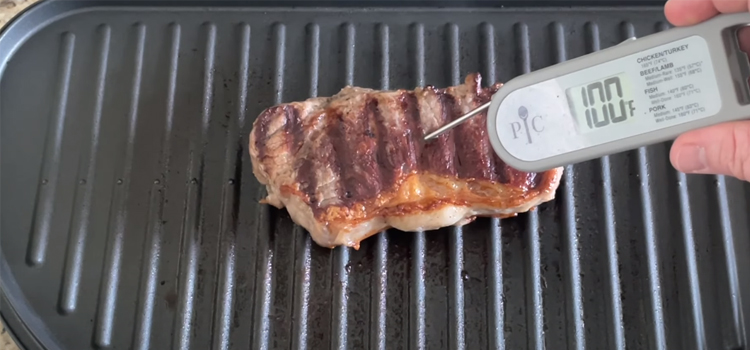Last Updated on September 13, 2024 by Shari Mason
Grilling over **blazing charcoal** in your backyard brings loads of fun and offers a great way to enjoy special times with **family and pals**.
But what if you’re out of charcoal or your grill doesn’t work? That’s where the George Foreman grill comes in handy.
This guide will teach you how to cook steak on a George Foreman grill, including a grilling guide that indicates doneness, internal temperature, and grilling time.
5 Steps to Cook Steak on a George Foreman Grill
1. Prepare Your Steak


Season the steak with salt and pepper or other herbs and spices.
Optionally, you can wipe a small amount of oil on both cooking plates or brush the steak lightly with oil before seasoning it for extra protection against sticking.
Read:
- How To Cook Salmon On George Foreman Grill?
- How To Cook Tri-Tip Steak Strips On The Stove?
- Can You Add More Charcoal While Cooking?
- How Long To Cook Frozen Burgers On George Foreman?
- How To Cook Salmon On A Griddle?
2. Heat Your George Foreman Grill


Plug in the George Foreman grill and let it heat up for 10 to 15 minutes or until the light indicator flashes green—make sure the grill is closed while heating.
You want the grill to be hot before you start grilling. Otherwise, the steak will get stuck and charred during the cooking process.
3. Throw the Steak on the Grill


Place the steak on the lower plate of the preheated grill and close the lid.
“There’s nothing like the smell of grilling flesh.”
Liv Tyler, American Actress, Producer, Singer & Former Model
Cook the steak for about 4 to 6 minutes, depending on its thickness and how well done you like it.
4. Check the Meat Temperature


Open the grill and use a meat thermometer to check the steak’s internal temperature.
For rare steak, the temperature should be around 125 degrees F; for medium, it should be 145 degrees F; and for well-done, it should be 165 degrees F.
5. Remove & Let It Rest


Remove the steak from the grilling plate and let it rest for 5 to 10 minutes for thinner cuts and 10 to 20 minutes for thicker cuts before slicing and serving.
Resting the steak allows the juices to be absorbed and redistributed throughout the meat to make for a more tender and juicy steak [1].
George Foreman Grilling Guide
| Doneness | Internal Temperature | Grilling Time |
| Rare | 120°F (49°C) to 130°F (54°C) | 4 to 6 minutes |
| Medium Rare | 130°F (54°C) to 140°F (60°C) | 8 to 10 minutes |
| Medium | 140°F (60°C) to 150°F (65°C) | 10 to 12 minutes |
| Medium Well | 150°F (65°C) to 160°F (71°C) | 12 to 14 minutes |
| Well Done | 160°F (71°C) to 170°F (77°C) | 14 to 16 minutes |
FAQs
u003cstrongu003eIs it good to cook steak with George Foreman grill?u003c/strongu003e
Yes, because the George Foreman grill’s design allows for even cooking on both sides of the steak simultaneously, and the ridges on the grill plates help create those desirable grill marks.u003cbru003eu003cbru003eFurthermore, the excess fat from the steak is collected in the drip tray, making it a healthier cooking method than pan-frying.
u003cstrongu003eDo you flip steak on George Foreman?u003c/strongu003e
Yes, you should flip the steak at least once because flipping ensures that it cooks evenly on both sides and helps create grill marks for a more attractive appearance. u003cbru003eu003cbru003eAs a general guideline, you can flip the steak after 2 to 3 minutes and then continue cooking until it reaches your desired level of doneness.
u003cstrongu003eShould I put oil on my George Foreman grill?u003c/strongu003e
Putting oil on your George Foreman grill is generally unnecessary, as the grill’s cooking plates already have non-stick properties that will help prevent sticking.u003cbru003eu003cbru003eHowever, if you prefer to use oil for flavor or to create grill marks, you can brush a small amount onto the steak before placing it on the grill. u003cbru003eu003cbru003eIt’s important to note that too much oil can cause excess smoke and damage the grill’s non-stick coating. So, it’s best to use oil sparingly or not at all.u003cbru003eu003cbru003eIn any case, if you’re cooking a fattier cut of meat, such as a ribeye u003ca href=u0022https://www.verywellfit.com/ribeye-steak-nutrition-facts-and-health-benefits-4845432u0022u003e[u003c/au003eu003ca href=u0022https://www.verywellfit.com/ribeye-steak-nutrition-facts-and-health-benefits-4845432u0022 target=u0022_blanku0022 rel=u0022noreferrer noopeneru0022u003e2u003c/au003eu003ca href=u0022https://www.verywellfit.com/ribeye-steak-nutrition-facts-and-health-benefits-4845432u0022u003e]u003c/au003e, you may not need to use any oil as the natural fat in the steak will provide enough lubrication to prevent sticking.
u003cstrongu003eCan you put a pan on a George Foreman grill?u003c/strongu003e
No, the George Foreman grill is designed to cook food directly on its non-stick cooking plates, and placing a pan on the grill may cause damage to the heating element or non-stick surface.u003cbru003eu003cbru003eFurthermore, using a pan on a George Foreman grill dismisses the purpose of the grill’s design, which is to cook food quickly and evenly on both sides while allowing excess fat to drip away.
In Summary
The George Foreman grill is an excellent, easy-to-use electric kitchen appliance that allows for indoor grilling and makes a great alternative to a traditional grill.
The grill features an angled non-stick cooking plate, preventing food from sticking and allowing for the steak’s excess fat to be drained away, making it a convenient cooking option.
Moreover, the grill cooks the steak evenly and relatively fast simultaneously due to its dual heating contacts, which is perfect for situations in which you don’t have time to cook.
References:
- https://www.seriouseats.com/how-to-have-juicy-meats-steaks-the-food-lab-the-importance-of-resting-grilling
- https://www.verywellfit.com/ribeye-steak-nutrition-facts-and-health-benefits-4845432
- Can You Put an AC Unit in the Kitchen? - September 27, 2024
- What Cheese Does Olive Garden Use? Discover Their Signature - September 27, 2024
- How to Cancel a Pizza Hut Order? Quick & Easy Guide - September 24, 2024


